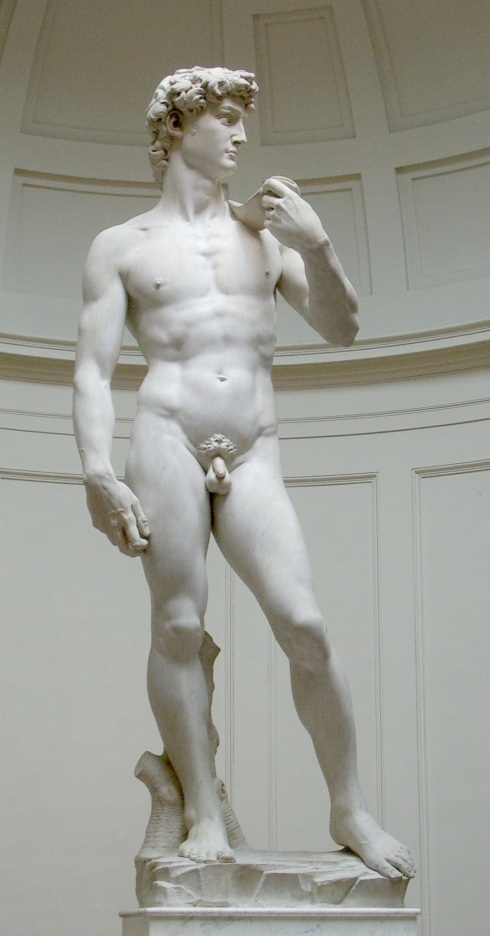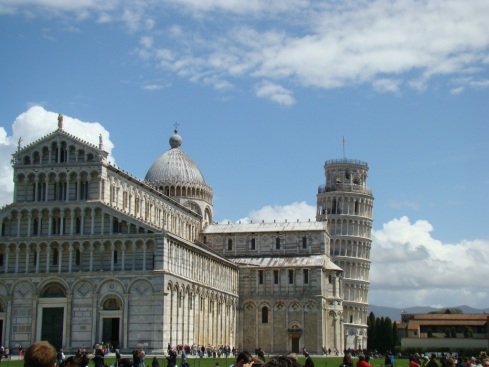Pisa – Florence Today is exciting, we are heading to the famous leaning tower of Pisa. The tower began to sink after construction had progressed to the second floor in 1178. This was due to a mere three-metre foundation, set in weak, unstable subsoil, a design that was flawed from the beginning. The height of the tower is 55.86 m (183.27 ft) from the ground on the low side and 56.70 m (186.02 ft) on the high side. The width of the walls at the base is 4.09 m (13.42 ft) and at the top 2.48 m (8.14 ft). Its weight is estimated at 14,500 metric tons (16,000 short tons). The tower has 296 or 294 steps; the seventh floor has two fewer steps on the north-facing staircase. Prior to restoration work performed between 1990 and 2001, the tower leaned at an angle of 5.5 degrees, the tower now leans at about 3.99 degrees. This means that the top of the tower is displaced horizontally 3.9 metres (12 ft 10 in) from where it would be if the structure were perfectly vertical.A popular tourist activity is to pose for photographs pretending to “hold up” the leaning tower and preventing it from falling. The illusion is created through the principle of forced perspective. My photo shows me using the power of the force. Yep, my hand is nowhere near it.
We got a fair bit of time to stroll round and take photos. After that it was up a side street for some lunch. Best pizza I’ve eaten all trip, and we’ve eaten some. Back onto the bus for our stay for the trip into Florence tomorrow to do some shopping and sightseeing.
Florence is the city that displays one of the most famous & beautiful sculptures I’ve been privileged to see. For those in the know it’s obviously the Michelangelo call David. It displays David in the seconds leading up to him slinging the rock at the giant Goliath and knocking him to the ground with a single stone. Our guide took us through the museum showing us the different marble pieces that were unfinished by Michelangelo. These are called the prisoners, you can see the figures trying to emerge from the marble but are frozen in time forever. One of them looks like he is trying to stretch out from a big yawn.
The David. What can I say? It’s a masterpiece. It’s beautiful. Go and have a look. It’s made of marble. Our guide says there’s some conjecture whether it’s good Carrara marble or from somewhere else. For those that don’t know ( we do ) Carrara marble is absolutely beautiful, every house should have some. Michelangelo wasn’t actually the first person to be given the commission of sculpting David. Originally commissioned as one of a series of statues of prophets to be positioned along the roofline of the east end of Florence Cathedral, the statue was instead placed in a public square, outside the Palazzo della Signoria, the seat of civic government in Florence, where it was unveiled on 8 September 1504. The artist Agostino di Duccio was the first to try, he only got as far as beginning to shape the legs, feet and the torso, roughing out some drapery and probably gouging a hole between the legs. His association with the project ceased, for reasons unknown, ten years later Antonio Rossellino was commissioned to take up where Agostino had left off. Rossellino’s contract was terminated soon thereafter, and the block of marble remained neglected for twenty-five years, all the while exposed to the elements in the yard of the cathedral workshop. On August 16, 1501, Michelangelo was given the official contract to undertake this challenging new task. He began carving the statue early in the morning on Monday, September 13, a month after he was awarded the contract. He would work on the massive biblical hero for more than two years. Hammer and chisel, polished by pumice stone. Bloody hell. Labour of love. In 1991 the foot of the statue was damaged by a deranged man with a hammer. Historians where able to learn a lot from the damaged pieces, eg: where the marble came from and that it contained many microscopic holes that cause it to deteriorate faster than other marbles. Because of the marble’s degradation, from 2003 to 2004 the statue was given its first major cleaning since 1843. Some experts opposed the use of water to clean the statue, fearing further deterioration after trying to clean it with acid damaging the left shoulder. It’s now housed in the museum and a replica is shown in the square. The statue has been reproduced many times. The plaster cast of David at the Victoria and Albert Museum has a detachable plaster fig leaf which is displayed nearby. The fig leaf was created in response to Queen Victoria’s shock upon first viewing the statue’s nudity, and was hung on the figure prior to royal visits, using two strategically placed hooks. She was not amused.
Florence is also famed for its leather. Oh yes indeed it is. Many $$ later, I brought a new nice jacket and Terri brought a hand bag for herself. I also brought myself a nice new wallet that was funded for me for my recent birthday by family. Very nice, easy to get carried away. Another nice lunch and off somewhere else tomorrow.
This post is not in line with the others as I accidentally deleted my work the other day. Wasn’t happy but I’m working on rectifying the prob. Love you all and we terribly miss you…. Well some of you.





Love the history lessons.